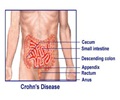Human body can be pushed to its optimal potential, just like athletes and Olympians do; but there are some ways of the human body that are still a mystery

Gastroenterology scientist Jan Huizinga and his team have learned that of the two types of movement, the segmentation motion occurs when not one but two sets of pacemakers interact with each other to create a specific rhythm. Then they work together with nerves and muscle to generate the movement that allows for nutrient absorption. The other type of movement moves the food along.
The discovery was made by Huizinga, a professor of medicine, and his researchers at the Farncombe Family Digestive Health Institute at McMaster University working with investigators of Wuhan University in China and colleagues at the University of Toronto. The paper was published by the prestigious science journal Nature Communications on Feb. 24.
"In the long run, it''s simple," said Huizinga. "It''s like when a stone is dropped in water, it creates waves or motion that pushes things along, but when a second stone is dropped in the water, the movement changes to up and down, appearing to stay in the same place."
The discovery is important as it gives direction for development of drugs or nutrients which will combat disorders when people have diarrhea, constipation, bloating or malabsorption of nutrients from food. With diarrhea, the segmentation activity is too low; in constipation, the same activity is too high and pain related to eating is often caused by abnormal contractions, said Huizinga.
The research was funded by the Canadian Institutes of Health Research and the National Natural Science Foundation of China. Several members of the research team are supported with scholarships from the Canadian Association of Gastroenterology, Hamilton Health Sciences and the Ontario government.
Source-Newswise
 MEDINDIA
MEDINDIA



 Email
Email







